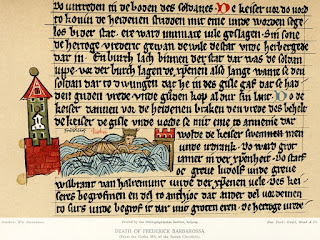He was quite useful at discussing The Anarchy in detail, and his chronicle gives a lot of insight to regular life in the 12th century. He is the only source for an event that happened in his lifetime: a bishop that became a pirate.
The 12th century in England had an interest—by no means unique to that time or place—in "revenants": animated corpses that haunted the living. I previously shared one of Newburgh's anecdotes in A Vampire at Melrose. Newburgh, who was a priest (an Augustinian canon), considered revenants a "warning to posterity" about living a spiritual life. To him, examples of revenants were so common that "were I to write down all the instances of this kind which I have ascertained to have befallen in our times, the undertaking would be beyond measure laborious and troublesome."
He acknowledges that these stories seem unlikely, but cannot bring himself to dismiss them:
It would not be easy to believe that the corpses of the dead should sally (I know not by what agency) from their graves, and should wander about to the terror or destruction of the living, and again return to the tomb, which of its own accord spontaneously opened to receive them, did not frequent examples, occurring in our own times, suffice to establish this fact, to the truth of which there is abundant testimony. [find the entire translated Historia here]
Another example offered by Newburgh is a criminal who flees York and marries a woman whose faithfulness he doubts. Hiding in the rafters of their house, he sees her with another man in their bed, but falls from the rafters, resulting in a fatal wound:
A Christian burial, indeed, he received, though unworthy of it; but it did not much benefit him: for issuing, by the handiwork of Satan, from his grave at night-time, and pursued by a pack of dogs with horrible barkings, he wandered through the courts and around the houses while all men made fast their doors, and did not dare to go abroad on any errand whatever from the beginning of the night until the sunrise, for fear of meeting and being beaten black and blue by this vagrant monster.
In fact, the revenant killed several people, whereupon the village decided to take action:
Thereupon snatching up a spade of but indifferent sharpness of edge, and hastening to the cemetery, they began to dig; and whilst they were thinking that they would have to dig to a greater depth, they suddenly, before much of the earth had been removed, laid bare the corpse, swollen to an enormous corpulence, with its countenance beyond measure turgid and suffused with blood; while the napkin in which it had been wrapped appeared nearly torn to pieces. The young men, however, spurred on by wrath, feared not, and inflicted a wound upon the senseless carcass, out of which incontinently flowed such a stream of blood, that it might have been taken for a leech filled with the blood of many persons. Then, dragging it beyond the village, they speedily constructed a funeral pile; and upon one of them saying that the pestilential body would not burn unless its heart were torn out, the other laid open its side by repeated blows of the blunted spade, and, thrusting in his hand, dragged out the accursed heart. This being torn piecemeal, and the body now consigned to the flames.
Newburgh doesn't seem to have tried to verify any of these stories, with any statement like "... and I heard this myself from one of the villagers who did the digging."
He was not the only person who recorded stories of revenants. Walter Map (mentioned in The Demonization of Cats post) relates more incidents.
I am hoping, though, that Newburgh 's account of a bishop who became a pirate—not referred to in any other known historical account—is true. I will check that out and report to you tomorrow. Until then...


























